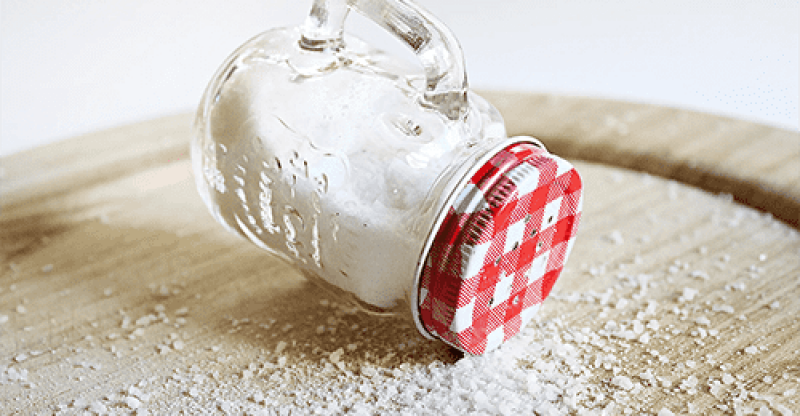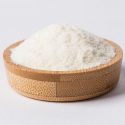What is Sodium Ferrocyanide (E535) in Salt and Is Cyanide in it Bad for you?

Production | Uses | Safety
Sodium ferrocyanide (decahydrate) also known as yellow prussiate of soda with the chemical formula Na4Fe(CN)6·10H2O. It is a cyanide salt used as an anticaking agent in table salts to keep them free flowing and with the European food additive number E535.
Given that it is a cyanide salt, you may be surprised why this ingredient can be in salt and is it really safe? Let’s move on.
How is it Made?
It is a synthetic compound that can be commercially produced by the reaction between sodium cyanide and ferrous sulfate in aqueous medium with heat condition as the following chemical equation indicates:
6NaCN + FeSO4 + Heat → Na4Fe(CN)6 + Na2SO4
Sodium ferrocyanide decahydrate can be then obtained after the process of crystallization.
It can also be made from the reaction among calcium cyanide, iron(II) sulfate, and sodium carbonate.
- CaCN2 + FeSO4 → Ca2Fe(CN)6 + CaSO4
- Ca2Fe(CN)6 + 2Na2CO3 → Na4Fe(CN)6 + 2CaCO3
Properties
Yellow crystals or crystalline powder, the yellow color comes from ferrocyanide anion ([Fe(CN)6]4-), iron is in the state of Fe2+.
| Other names | Sodium hexacyanoferrate, Tetrasodium hexacyanoferrate |
| CAS number | 14434-22-1 |
| Chemical formula | Na4Fe(CN)6 · 10H2O |
| Molecular weight | 484.1 |
| Solubility | Soluble in water, insoluble in ethanol |
Why does Sodium Ferrocyanide Used in Table Salts?
Sodium ferrocyanide is the cyanide complex and its major purposes in food is as an anticaking agent in salts (table salt, sea salt, iodized and non-iodized salt) for human consumption. It is vegan and gluten free.
The surface of crystals of table salt is easy to dissolve after absorbing moisture in air with high humidity, and then recrystallization occurs after water evaporation. Finally, caking, lumping, or aggregation occurs.
Some kinds of salt added with small amounts of sodium ferrocyanide to prevent such caking (or clumping) and by reducing the amount of recrystallization through decreasing the solubility of sodium chloride in water.
Is Sodium Ferrocyanide Safe to Eat?
First of all, please be assured that there are almost no side effects of sodium ferrocyanide when used as a food additive. Its safety has been approved by the U.S. Food and Drug Administration (FDA) and European Food Safety Authority (EFSA), as well as the Joint FAO/WHO Expert Committee on Food Additives (JECFA). So please don’t worry about it.
The safety concern is generally caused by its chemical name containing cyanide, a known toxin.
As you can imagine, fears may present in many consumers if they see ferrocyanide (a cyanide complex) listed in the salt label, and that’s why most salt manufacturers prefer to label it as “yellow prussiate of soda”.
Many salts of cyanide are dangerous, but the cyanide in food grade ferrocyanides is non-toxic as it is tightly bound to an iron atom and so does not tend to release free cyanide.
In acidic environments, the bonds between sodium and ferrocyanide will break, and the toxic gas – hydrogen cyanide gas will be released (1), but the stomach acid is a weak acid that cannot promote this reaction in our body.
If you’re still afraid of this ingredient, you can turn to other anticaking agents commonly used in table salts, such as silicon dioxide, sodium silicoaluminate and calcium silicate.
FDA
Yellow prussiate of soda functions as an anticaking agent in salt And as an adjuvant in the production of dendritic crystals with the maximum addition of 0.0013% expressed as sodium ferrocyanide anhydrous. (2)
It can also be safely used as an anticlumping agent in salt for animal feed. (3)
EFSA
Sodium ferrocyanide (E535) is listed in Commission Regulation (EU) No 231/2012 as an authorised food additive and categorized as “additives other than colours and sweeteners”.
Ferrocyanides (potassium ferrocyanide, sodium ferrocyanide and calcium ferrocyanide) are only approved to be used in salt and salt substitutes with the maximum level 20 mg/kg individually or in combination (calculated as potassium ferrocyanide anhydrous). (4)
Safety re-evaluation in 2018
EFSA concluded no safety concern at the current authorised use and use levels of sodium ferrocyanide in its safety re-evaluation report in 2018.
The following are some key points (5):
- Its absorption in human is low and no accumulation.
- No genotoxicity and no carcinogenicity.
- Considering the only toxicity of ferrocyanide ion to the kidney, an acceptable daily intake (ADI) of 0.03 mg/kg bw per day (expressed as ferrocyanide ion) was established.
JECFA
Function class: food additive, anticaking agent. (6)
Acceptable daily intake: ADI “0-0.025 mg/kg bw” set in 1974. (7)
Conclusion
Now you may have an understanding of the food additive – Sodium ferrocyanide or Yellow prussiate of soda (E535), from its production; function in table salts; the approved safety; where the health issues come from and the safety of Cyanide in it.
What do you think of this anticaking agent? Let me know in the comments.



Where I am fairly comfortable with Sodium Ferrocyanide in Table Salt, the impact on kidneys over an extended length of usage is of concern. My chief concern with Food additives are the additives which greatly contribute to oxidative stress. I am of course referring to Free Radicals. This subject is avoided like the plague. Nitrites/Nitrates are also a major concern. Discuss
I will very carefully purchase only salt without any additives including NaFeCN.. A salt grinder of non-additive containing salt crystals seems like a good idea
Poison,it is bad for your kidneys, anyway you use salt every day,no thanks ,i keep my organic one with any caking agente,any additive us bad
Note a correction – Stomach acid, HCL, is a strong acid.
Also note that standard levels do not take into account those people with, eg a leaky-gut, who may absorb a lot more. Hence so many people suffering from eating the standard western diet of gluten, dairy and nightshades, in addition to the biocides in food.
Hi James, thanks for this article. I know it’s a few years ago. Taking into account that the FDA and all the other bodies like the WHO have over 80% of their wages paid by the very industries they regulate I’m not sure they are the best source of info or facts. For me I have completely changed my diet (last 2 years) and only eat whole/real food. It is said 75% of human chronic illness comes from the rubbish food everyone is eating. Trev.
For those who want to read less, I am consuming, as I write this, 20 times the amount of cyanide in a days table salt, from a small hand full of almonds.
The negative comments here would seem unwarranted based on the EFSA Safety re-evaluation in 2018 and JECFA. They indicate a max. consumption limit of approximately 0.03mg/Kg body weight per day. Unfortunately, I was unable to review the original sources of this data because the links did not work. I did find a WHO reference (https://www.inchem.org/documents/jecfa/jecmono/v05je02.htm) and Wikipedia says about same thing.
Assuming a 50 Kg (110 lb) human that would be about 1.5 mg/day. FDA indicates a limit of 0.0013% in salt. So 1 g salt could contain up to 0.000013 g or 0.013 mg. Our 50 Kg human probably consumes 1.5 -2 g salt per day so that would be at the outset 0.026 mg/day or about 1/50th of the limit of recommended consumption. That seems to me like a pretty decent safety factor.
Another fact is that almonds contain about 25mg/kg cyanide (https://www.hindawi.com/journals/isrn/2013/610648/). So 10 g, about a tablespoon full would contain 0.25 mg of cyanide. Another crude calculation (156g cyanide/304g sodium cyanide) indicates this is equivalent to 0.5 mg of anhydrous sodium ferrocyanide. As I consume the 10 g of almonds I weighed out, I will consume about 20 times as much cyanide, as I will get all day from salt.
Although, I am a chemist, this was a cursory, spur of the moment calculation, and might be off, because the data may refer to different forms of the ferrocyanide compound (one reference is to anhydrous sodium ferrocyanide and this may be common practice) or I may have just made a dumb mistake. Feel free to check my calculations, Most people with rudimentary math skills should be able to do that as well as this 80 yr old chemist. That may not be true of the molar calculation. For each sodium ferrocyanide molecule, roughly half the weight is cyanide. Yes, my cyanide tastes good.
I don’t trust the FDA or the WHO. No one should.
thanks for the reassurance. Just opened a fresh 1.5 kg bag of table salt and read the label. Woah! ferroyanide is that. safe? I only use salt when baking bread so I guess my exposure is well within safe limits, but next time I’ll read the label before buying
“As I consume the 10 g of almonds I weighed out, I will consume about 20 times as much cyanide, as I will get all day from salt.”
Oh then that’s ALL ALRIGHT then…
Fatuous highly selective narrative control BS like this, is why any well educated and intelligent person should never trust smug little ‘innocent-moi’ scientists one inch. All bought and paid for by Corporate, whose underhand and expedient methods we- the smart people get to see first hand, because in many instances -WE’RE MANAGEMENT AND DOING THAT IS OUR JOB!
Offer enough, or even better, average amounts in a buyers market and they’ll come running. Once their contracted in, we control the money and status tap, and they’ll do what they’re told, or they’ll be replaced by someone that does. All done by off-balancing jargon, narrative control and ‘restructuring’. Us social scientist grads can out smart a NatSci anyday of the week! Bit pathetic really- like shooting fish in a barrel, and they dutifully paint their own bulls-eyes on themselves too!
Money not truth is KING, so if there’s a profit in lying about ferrous cyanide’s health issues then lie they will. A few decades ago I removed a business’s specs for a building damp proofing fabric because it has a cyanide compound in. I read the BS and seeing its investigative limitations ignored it, as I trust the compound changing abilities of FIRE far more than I did the half baked superficial AUTHORITATIVE ‘justifications’ by the manufacturers and the then Industry Research establishment, who themselves sold out to private profit a few years later.
Its always ‘SAFE’ until the day it isn’t anymore. Use your common sense, and in 50 years time they’ll do that report that normal people respond by saying “We knew that all the time’.
Common Sense and CYANIDE….?
I looked up sodium hexacyanoferrate as I want to preserve beans by salting. An old recipe book says to use cooking salt rather than table salt, and I guess this means without anti-caking agent,yet I’m having trouble finding this at a reasonable price.